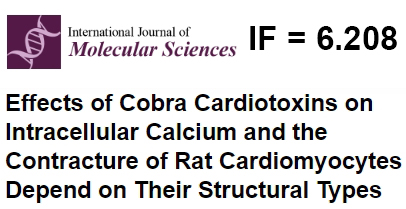Press-room / news / Science news /
Effects of cobra cardiotoxins on intracellular calcium and the contracture of rat cardiomyocytes depend on their structural types
Scientists from the Department of Molecular Neuroimmune Signaling of the Institute of Bioorganic Chemistry, Russian Academy of Sciences, together with colleagues from the Institute of Cell Biophysics and the Institute of Theoretical and Experimental Biophysics, studied the effect of cobra venom cardiotoxins on the intracellular concentration of calcium ions and the shape of rat cardiomyocytes.
Depending on the structure of the N-terminal or the central polypeptide loop, they are classified into either group I and II or P- and S-types, respectively, and toxins of different groups or types interact with lipid membranes variously. While their main target in the organism is the cardiovascular system, there is no data on the effects of CaTxs from different groups or types on cardiomyocytes. To evaluate these effects, fluorescence measurement of intracellular Ca2+ concentration and assessment of the rat cardiomyocytes shape were used. The obtained results showed that CaTxs of group I containing two adjacent proline residues in the N-terminal loop were less toxic to cardiomyocytes than group II toxins and CaTxs of S-type were less active than P-type ones. The highest activity was observed for Naja oxiana cobra cardiotoxin 2 which is of P-type and belongs to group II. For the first time the effects of CaTxs of different groups and types on the cardiomyocytes were studied, and data obtained showed that the CaTx toxicity to cardiomyocytes depends on the structures both of the N-terminal and central polypeptide loops.

Figure 1. Change in the shape of a cardiomyocyte over time after application of 25 µM CaTx at t = 0.
The paper was published in the International Journal of Molecular Sciences (IF 6.208, Q1) as part of the Special Issue Molecular Mechanisms of Animal Toxins, Venoms and Antivenoms and was supported by the Russian Science Foundation on the topic "Proteins and peptides from snake venoms affecting the cardiovascular system - fundamental basis of new cardioprotective and antihypertensive drugs". (Project number: 21-14-00316, head Professor Yu.N. Utkin).
june 23, 2023


